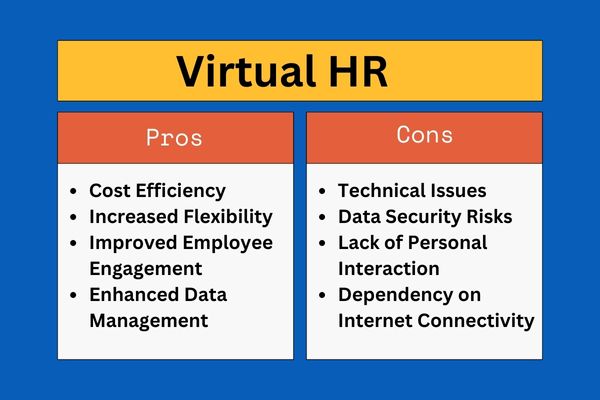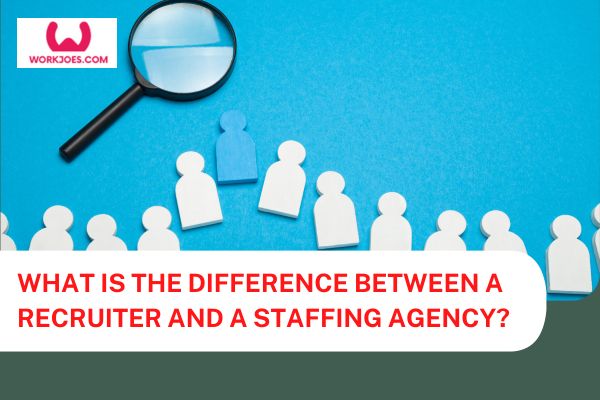Virtual HR, or virtual human resources, is a modern approach to managing HR operations remotely. It involves using technology to manage employee data, payroll, benefits, and other HR functions. With the rise of remote work and the need for flexible work arrangements, virtual HR has become an increasingly popular option for businesses of all sizes.
What is Virtual HR? Virtual HR eliminates the need for an HR representative, It connects employees directly to HR services through a self-service platform powered by technologies.
One of the key advantages of virtual HR is its flexibility. It allows HR professionals to work from anywhere, which can be especially beneficial for businesses with a distributed workforce. It also makes it easier to manage HR operations across multiple locations.
However, there are also some potential drawbacks to virtual HR, including security concerns and the need for strong communication and collaboration tools. In this article, we will explore the pros and cons of virtual HR and provide insights on how to implement it effectively.
Key Takeaways
- Virtual HR is a modern approach to managing HR operations remotely using technology.
- The main advantage of virtual HR is its flexibility, but there are also some potential drawbacks to consider.
- To implement virtual HR effectively, businesses need to ensure they have strong communication and collaboration tools and robust security measures to protect employee data.
Understanding What Is Virtual HR
Virtual HR, also known as e-HR or online HR, refers to the use of technology to manage various HR functions and processes. It involves the use of software, web-based platforms, and other digital tools to streamline HR tasks such as recruitment, onboarding, performance management, and employee engagement.
One of the main advantages of virtual HR is that it allows for greater flexibility and accessibility. With virtual HR, employees can access HR services and information from anywhere, anytime, using a computer, tablet, or smartphone. This can be especially beneficial for remote workers, as well as for companies with multiple locations or a global workforce.
Another benefit of virtual HR is that it can help to reduce costs and increase efficiency. By automating many HR tasks, companies can save time and resources, and free up HR staff to focus on more strategic initiatives. Virtual HR can also help to ensure consistency and accuracy in HR processes, reducing the risk of errors and compliance issues.
Despite these benefits, virtual HR is not without its challenges and drawbacks. One potential disadvantage is that it may be less personal and less effective in building relationships with employees. Additionally, there may be concerns about data security and privacy when using online platforms to store sensitive employee information.
There are many companies like Wendy Sellers (The HR Lady) and BambooHR, that offer these services.
Virtual HR can be a valuable tool for companies looking to streamline HR processes and improve efficiency. However, it is important to carefully consider the pros and cons before implementing virtual HR solutions and to ensure that appropriate measures are taken to address any potential risks or challenges.

Advantages of Virtual HR
Cost Efficiency
Virtual HR offers significant cost savings compared to traditional HR models. We can reduce overhead costs by eliminating the need for a physical office, reducing travel expenses, and minimizing the need for on-site staff. Additionally, virtual HR providers can offer a range of services at a lower cost than hiring in-house HR staff. By outsourcing HR functions to a virtual provider, we can save money and allocate resources more efficiently.
Increased Flexibility
Virtual HR offers greater flexibility than traditional HR models. We can access HR services from anywhere, at any time, using a variety of devices. This flexibility allows us to respond quickly to changing business needs, such as expanding into new markets or scaling up operations. Virtual HR providers can also offer customized solutions tailored to our needs, allowing us to focus on our core business.
Improved Employee Engagement
Virtual HR can improve employee engagement by offering a range of services that help employees feel supported and valued. For example, virtual HR providers can offer online training and development programs, employee recognition and rewards programs, and wellness programs. These services can help us attract and retain top talent, increase employee satisfaction, and improve overall productivity.
Enhanced Data Management
Virtual HR offers enhanced data management capabilities compared to traditional HR models. With virtual HR, we can access real-time data and analytics on HR metrics such as employee turnover, performance, and engagement.
This data can help us make informed decisions about our HR strategy, identify areas for improvement, and measure the effectiveness of HR initiatives. Additionally, virtual HR providers can offer secure, cloud-based systems for data storage and management, ensuring that our HR data is safe and accessible.
Disadvantages of Virtual HR
Technical Issues
One of the major drawbacks of virtual HR is the technical issues that may arise. Technical problems such as software glitches, server downtime, and internet connectivity issues can cause delays and disruptions in the HR process. These issues can lead to frustration among employees and HR professionals alike, and may even result in loss of productivity.
Data Security Risks
Virtual HR also poses a risk to data security. With sensitive employee information being stored and transmitted online, there is always a risk of data breaches and cyber-attacks. Organizations need to ensure that they have robust security measures in place to protect employee data and prevent unauthorized access.
Lack of Personal Interaction
Another disadvantage of virtual HR is the lack of personal interaction. Virtual HR eliminates face-to-face interactions between HR professionals and employees, which can make it difficult to build relationships and establish trust. This lack of personal interaction can also lead to misunderstandings and miscommunications, which can negatively impact employee morale and job satisfaction.
Dependency on Internet Connectivity
Finally, virtual HR is heavily dependent on internet connectivity. Without a stable and reliable internet connection, HR professionals may not be able to access the necessary tools and resources to carry out their duties effectively. This can lead to delays and disruptions in the HR process, which can have a negative impact on employee satisfaction and productivity.
Conclusion:
Virtual HR is changing the way HR works. It gives a lot of flexibility, cost-effectiveness, and access to a broader talent pool. As organizations adapt to remote work models, Virtual HR offers a viable solution for seamless HR operations.
However, it’s crucial to weigh the pros and cons before embracing Virtual HR. Organizations can choose from reputable Virtual HR companies such as BambooHR, TalenLyft, ClickOnHR, StrategicHR, and The HR Lady to unlock the full potential of Virtual HR and drive organizational success.







